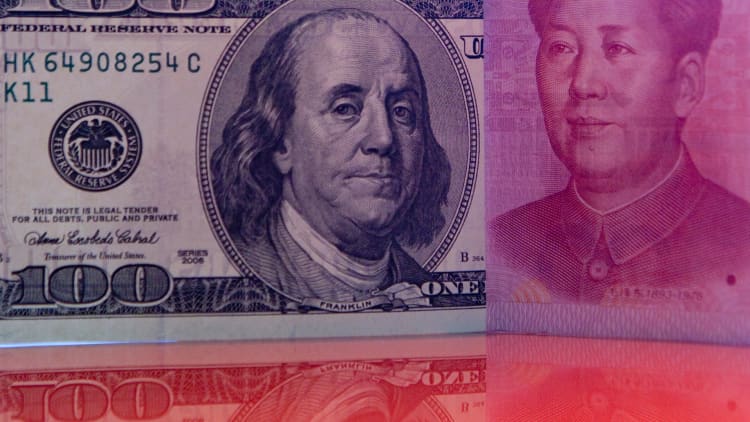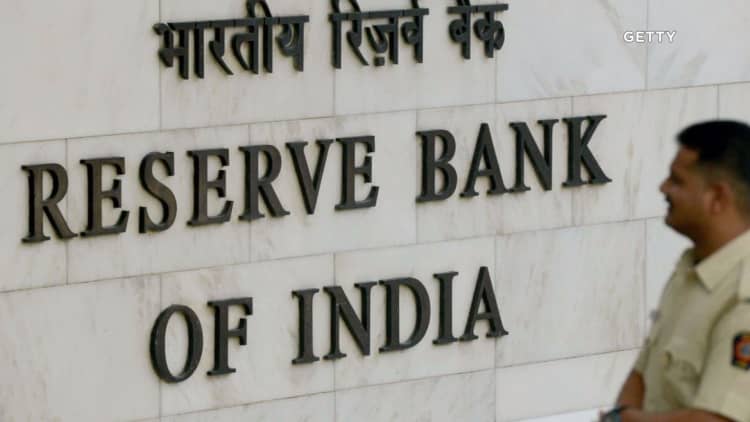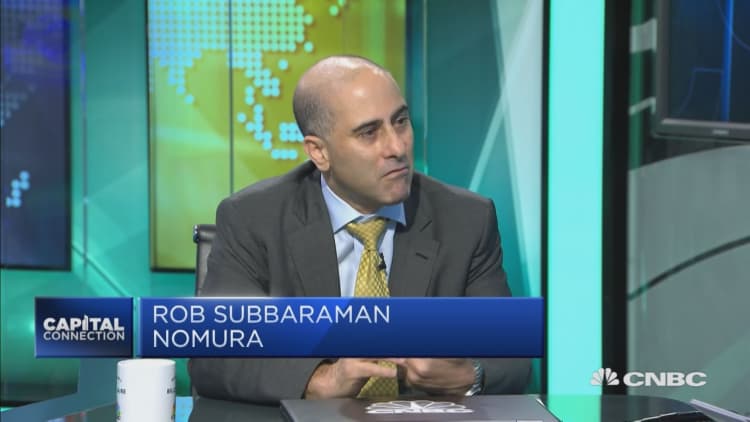
India's persistent buying of the U.S. dollar to keep its local currency cheap has caught the attention of the U.S. Treasury, increasing the risk that Asia's third-largest economy could soon face the ill effects of a "currency manipulator" branding.
India came under the spotlight after an increase in the "scale and persistence" of its buying up other nations' money, the Treasury said in an October report outlining the foreign exchange policies of the U.S.'s major trading partners.
But even without the official "currency manipulator" label, being called out by the U.S. Treasury can already limit New Delhi's freedom in managing the rupee, analysts said. To avoid the designation, the Reserve Bank of India may be looking to reduce its foreign exchange purchases. Doing so at a time when capital inflows are still strong, however, could be costly for the economy, as its domestic currency may become expensive and hurt the country's competitiveness.
The RBI did not respond to CNBC's request for comment about the report.

India's net currency purchases rose to around $42 billion, or 1.8 percent of its gross domestic product, in the 12 months from July, 2016 to June, 2017, the Treasury said. Compared to the $10 billion, or 0.4 percent of GDP, net purchases in calendar year 2016, New Delhi has been on a buying spree.
"Over the first half of 2017, there has been a notable increase in the scale and persistence of India's net foreign exchange purchases," the Treasury said, adding that it will be "closely monitoring India's foreign exchange and macroeconomic policies."
The RBI intensified the buying of foreign currencies this year after a surge in capital inflows into India's stocks and bonds sent the rupee appreciating to its strongest in two years against the U.S. dollar. The purchases — to ensure the rupee does not rise to a level that would harm its exporters and other internationally operating firms — also saw India's foreign reserves hitting an all-time high of $402.51 billion in September.
Those currency moves could potentially lead to India's inclusion on the U.S. Treasury's manipulator watchlist, and so the RBI may be looking to pull back on its defense of a cheap rupee. That would see the Indian currency jump in relative value, which would cause negative effects for wide swaths of the economy.
And, if India feels limited in its ability to buy up international currencies, that will also affect its efforts to create robust foreign reserves that would protect against economic shocks.
That's something that New Delhi should be doing more of, according to Rajiv Biswas, APAC chief economist at IHS Markit. The country should increase its reserves "significantly further" as its current account deficit makes it particularly vulnerable in the event of a capital flight, he explained.
"Increased FX (foreign exchange) reserves help to reassure global financial markets that India is resilient to external shocks, particularly hot money outflows," Biswas said in an email. "FX reserves are essentially like a fire insurance policy — in good times you complain about the cost, but you only fully understand their value when markets are in meltdown and a currency crisis looms."
But the RBI's options are limited if India wants to avoid further scrutiny by the Treasury. The report, published twice a year, is intended to flag any unfair currency practices, and lists three criteria that define an unfair practice.
The first is that a country has at least a $20 billion trade surplus with the U.S. (meaning the value of goods it exports to the U.S. exceeds the value of its American imports by that much). The second criterion is that a country has net foreign currency purchases of at least 2 percent of GDP over a 12-month period.
And the final characteristic is if a country has a current account surplus that's at a minimum 3 percent of GDP. The current account is a measurement of goods, services and investments that go in and out of a country.
Economies that fulfill two out of the three criteria are put on a monitoring list, which increases the risks of trade sanctions from the U.S. and earning the label "currency manipulator." Five countries are now officially being watched: China, Japan, South Korea, Germany and Switzerland.
India, however, currently meets only one of those criteria: Its trade surplus with the U.S. came in at $23 billion in the 12 months to June — higher than the $20 billion threshold. The country's current account deficit and net foreign exchange purchases of 1.8 percent of GDP are helping it avoid being placed on the monitoring list for now.

"We reckon that the U.S. is paying more attention to India this time around as the economy is very close to meeting (the foreign exchange criterion)," Radhika Rao, economist at DBS Group Research, wrote in a note. "This reflects strong rupee appreciation in the first half of the year, which forced the central bank's hand to intervene to keep real gains in check."
To avoid a place on the monitoring list, India could reduce its trade surplus with the U.S., but analysts said the pressure to do so is low given that countries such as China and Japan have far larger trade surpluses with the world's largest economy. That leaves the RBI with only one possibility: slow down its intervention in the currency markets to keep net foreign exchange purchases below the stipulated 2 percent of GDP.
That is "an important step" to take, even if it could result in the rupee appreciating in the short-term, Biswas said. But DBS' Rao said the central bank will likely face less pressure to buy foreign currencies as much as it did before as capital inflows have slowed in recent weeks.
"Interest in the Asian emerging markets may be cooling off as flows into the region have moderated in recent weeks," she said. "In all, we see little risks that India might be officially included in the list of economies monitored (by the U.S. Department of Treasury)."
WATCH: How can India's government address the country's bad loans issue?



